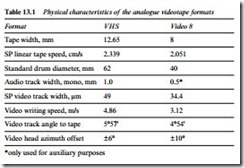TRACK CONFIGURATION
As is plain from Fig. 13.2 the scan paths of the video heads make a small angle to the tape ribbon itself, typically 5°, to write a narrow track some 10 cm long into the tape. The angle and alignment of the head-guide rabbet is such that the heads do not sweep over the entire 12.65 mm (^ in) width of the tape ribbon; margins are left at the edges to accommodate longitudinal tracks, used in some formats for sound and tracking-control signals. The standard VHS track pat- tern is shown in Fig. 13.3(a). Here the tape advances at 2.34 cm/s to
give tracks 49 microns wide. They are scanned from bottom to top of the tape. The upper tape edge is reserved for a conventional sound track 1 mm wide. The lower tape edge carries the control track, which provides a positioning reference for the video tracks themselves, and is used to guide the head sweeps during replay. This topic will be examined in more detail later.
Tape parameters for Video 8 are given in Fig. 13.3(b). A major difference from VHS is the tape width. This narrow tape lends itself well to portable, mobile and lightweight video applications, especially since its cassette package (95 × 62.5 × 15 mm) is little bigger than an audio type. Except for special applications like programme indexing/ cueing and other auxiliary signals, the V8 format has no need of longitudinally recorded tracks. Tracking-control signals in an ATF (Automatic Track Finding, see later) system are recorded along with the video signals themselves, and sound is also carried in the narrow helical tracks – this technique of sound-with-vision (hi-fi) record and playback will be examined in Chapter 17, and is essential in the V8 system since the linear tape speed – approximately 2 cm/s in standard- play mode and 1 cm/s in LP mode – would render very low quality sound from a stationary-head system.
Other features of V8 technology are a facility for PCM (Pulse Code Modulation) audio recording on a 30° extension of the video track; a relatively low writing speed of 3.1 m/s, due to the conveniently small head-drum diameter of 40 mm; and a 34.5 micron track width, which in LP mode reduces to 17.2 micron.
Format parameters
Table 13.1 gives a comparison of the main physical features of each format in current use. In comparing the data and dimensions in Fig.
13.2 and Table 13.1 the following general points should be borne in
mind: (a) Narrow video tracks give high recording density on tape but an inferior noise performance; at track widths below 25 micron good tracking is difficult to achieve without an ATF system. (b) Head-drum diameter is directly related to video-track writing speed; the larger the drum (for a given wrap angle, i.e. 180°) the greater the writing speed and the wider the frequency response. (c) Linear tape speed determines the sound-channel frequency response where longitudinal tracks are used – the higher the speed the greater the frequency range. In analogue formats all half-wrap head drums for use with 50 field/s TV systems rotate at 1500 r.p.m. in order that one half-revolution occupies exactly the period of one TV field; in 60 Hz systems (USA, Canada etc.) the head-drum speed is 1800 r.p.m.

